In our last post we wrote about our visit to the Hassan II mosque in Casablanca, Morocco. Today we want to tell you about some of the other places we visited during our trip. In our next post we’ll talk about some of the food we tried while we were there.
It’s not that far away
Casablanca is only a 90 minute flight from Lisbon. We know people who have gone there for long weekends, but we wanted to take our time and see more of the country.
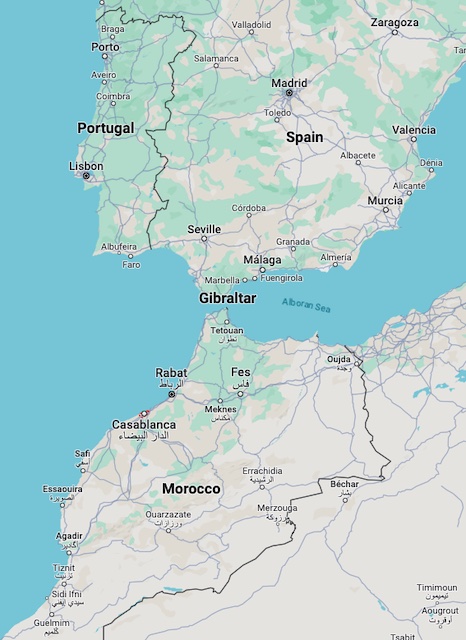
After talking with several friends who had traveled there, we decided we wanted to go as part of a tour group. We had done a Rick Steves tour of Europe in 2006 and enjoyed the small group and the planned itinerary. It seemed to us that having knowledgeable guides and defined travel plans would be important for our first visit to Morocco, so we started looking for options.
The trip we planned
After a bit of research, we settled on a tour offered by Intrepid Travel. While we had never traveled with them before, the reviews and independent reports we read were encouraging. We also liked the fact that they are a certified “B Corporation”, which means they are a company with social and environmental missions, in addition to a profit motive. They use local guides, book tour groups into small, locally-owned hotels, and arrange meals at locally-owned restaurants – all ways of supporting the communities that they visit.
The tour would begin in Casablanca, and take us north through Meknes and Moulay Idriss to Chefchaouen. Then south to Fes, Midelt, and the Sahara Desert.
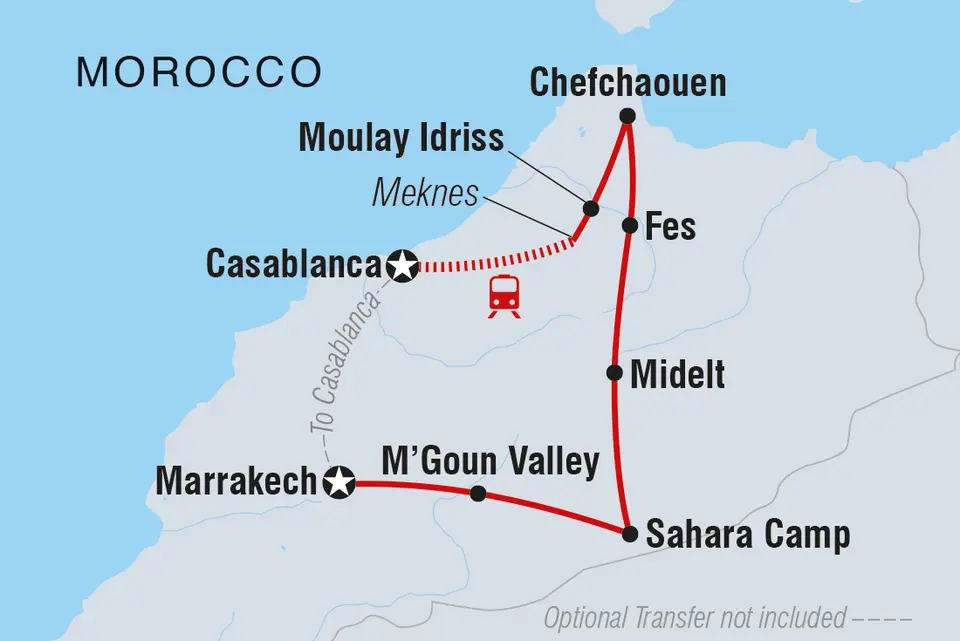
Image credit: Intrepid Travel
In the desert we would ride camels, take Instagram photos, and stay in a tent. The adventure would continue westward, ending in Marrakech.
During this 11 day adventure we would have cooking demonstrations and many opportunities to sample the local cuisine.
We were in!
The trip we actually took
We’ve often said, “Man plans and God laughs”. This trip was no exception, and She must have gotten a real chuckle.
Day One went fine. We met our tour group on a Friday evening in our Casablanca hotel. There were eleven of us, a real international group – Cathy, Jonathan, Steve, and Gladys from the US; Daniel from Italy; Dora from Singapore; Mina from South Africa; and Jill and Nicola from Australia. Abderrahim was our Moroccan guide. He briefed us on on the itinerary, laid out the ground rules, and assured us we were going to have a great time.
On Day Two (Saturday), as we traveled north, we got word from our dog sitter in Lisbon that our Boston Terrier, Sox, was ill. We gave some suggestions about medication and changes to her food, but as the day progressed, Sox got worse. By evening she had to be admitted to a veterinary hospital.
During Day Three and Four (Sunday and Monday) we had periodic WhatsApp messages about Sox’s condition. She was still in the hospital and wasn’t getting better. The vets wanted to do some serious tests. By Monday evening, when we arrived in Fes, we made the decision to go home. So on Tuesday morning we said goodbye to our new friends on the tour and took a taxi to the train station.
It took two days to get from Fes to Marrakech and back to Lisbon. During that time we had regular messages and calls with the vets. We made it back by Wednesday evening.
The places we saw
Despite the interruptions and the worry about Sox, we got to see several of the cities on the itinerary, as well as a lot of the countryside. Here are some of our impressions.
Our first look
Even before we landed, our preconceived notions about Morocco were challenged. As we flew in to Casablanca, we were surprised by the green terrain below us. It wasn’t all desert!
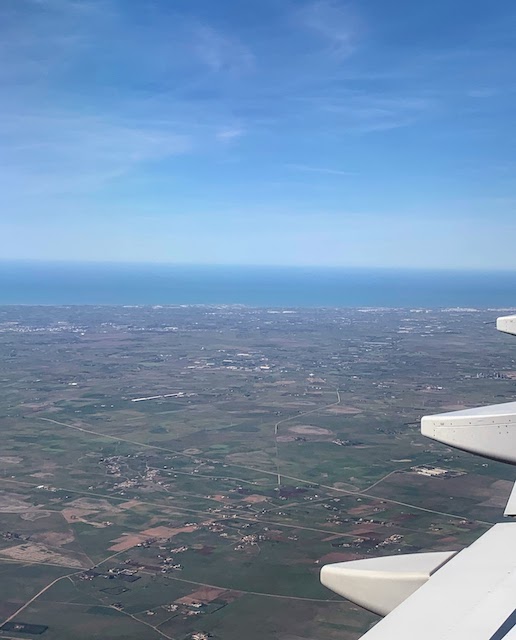
We went a day early to have some time to see Casablanca. The highlight of the day was our visit to the Hassan II mosque. During a driving tour of the city we noticed Moroccan flags flying at every corner. Our guide told us that the flags were flown whenever the King was in the city.
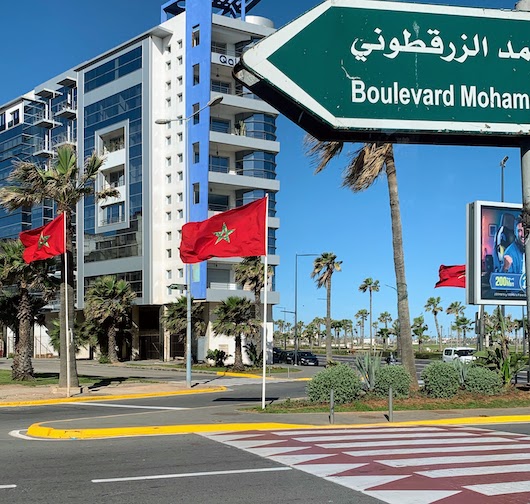
Meknes
We took a train from Casablanca to Meknes. It was the weekend after Ramadan and many people were traveling home after the Eid al-Fitr holiday. The train was crowded, but we all had seats for the 3 1/2 hour trip.
After we left the city, we saw green hills and small farms. We could have been “out in the country” almost anywhere. There were lots of olive groves and fields full of onions.
Meknes is one of four “Imperial Cities” in Morocco. These are the cities that have been, or are now, the capital of the country. (The other three are Fes, Marrakech, and Rabat, the current capital.)
When we arrived in Meknes, we walked to a small restaurant where we met Mady, our local guide. After lunch she took us on a walking tour of the city.
We spent some time in the medina and got our first real introduction to the old marketplaces that are found in nearly every city. As we walked up one street filled with smoke and good smells from cooking fires, a member of our group was admiring a patron’s lunch. He smiled and handed her a piece – “Try some goat”, he said. She took it, thanked him, and passed it around so we all got a small bite. It was delicious.
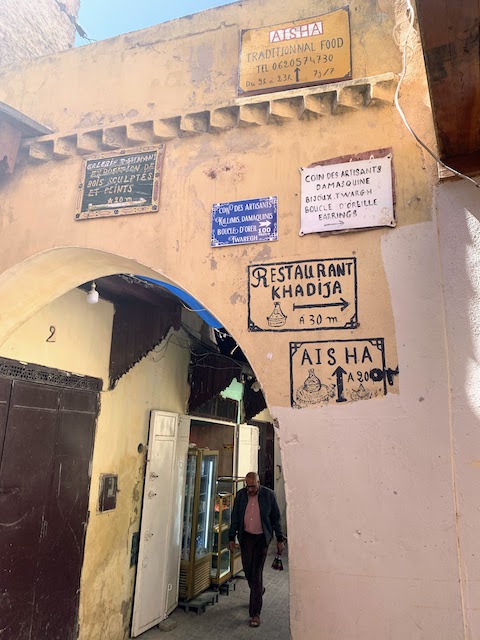
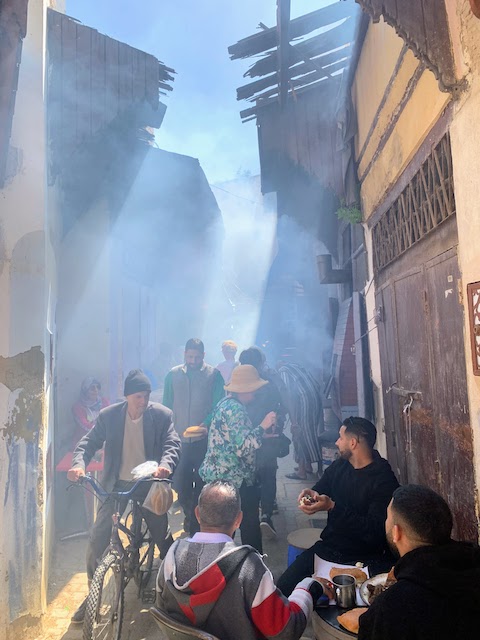
Meknes is the only city in Morocco where the art of damascene is practiced. This is an ancient craft where thin strands of silver are hammered into grooves cut in metal plates. We visited a shop where damascene articles were on display and watched an artisan as he worked on a new decorative plate.
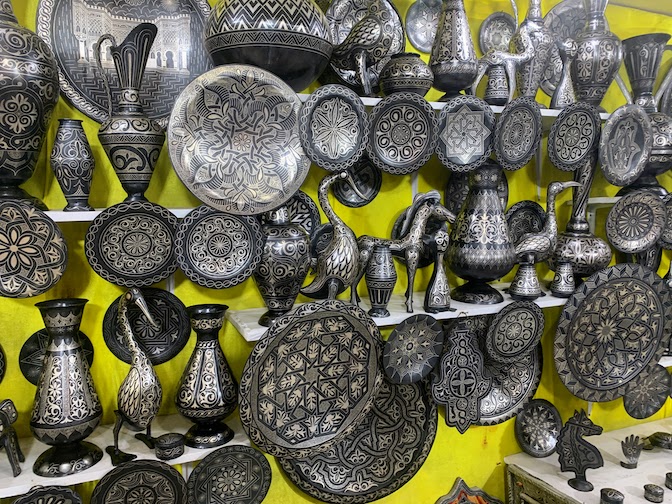
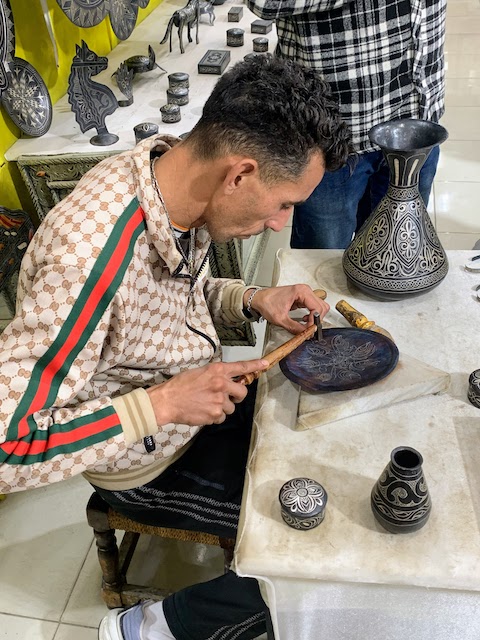
Yes, we came home with a few small pieces.
Moulay Idriss
The town of Moulay Idriss is built on a hillside, a short drive from Meknes. Wherever you go in the city, you’re either climbing stairs or coming down. We spent the night in a guesthouse there.
Before supper we climbed up many stairs between painted walls to reach an overlook where we could watch the sunset. The view was stunning – a pastel sky above the multicolored patchwork of the city.
Image credit: Jonathan Jacobs
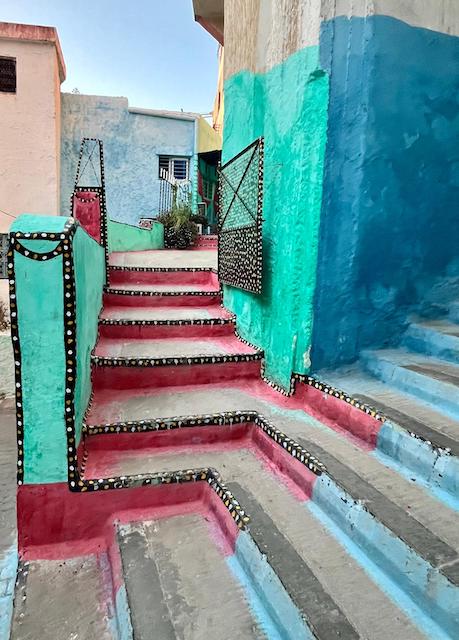
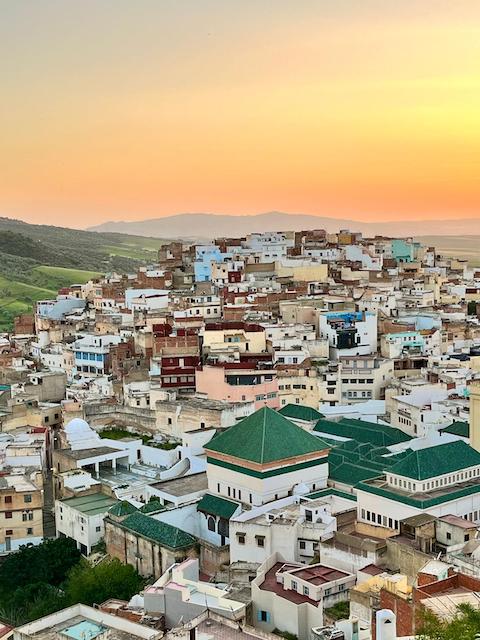
the local mosque and madrassa (Islamic school).
Image credit: Jonathan Jacobs
This gentleman and his donkey had hauled our luggage up the stairs to the guest house the night before. He was back early the next day to get us loaded onto the bus.
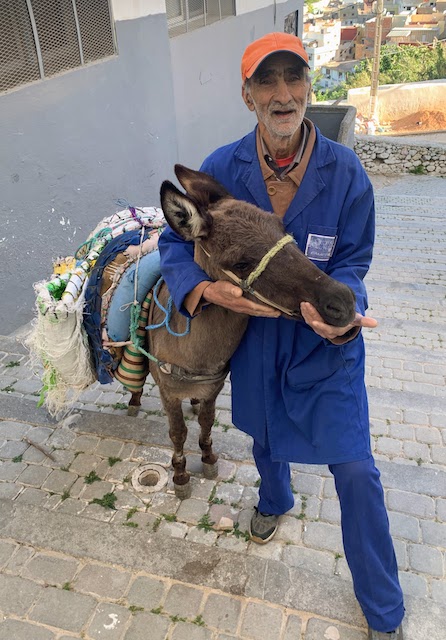
Chefchaouen
As we drove from Moulay Idriss, we saw more olive groves and onion fields. There were also many large agave plants growing along the roadside. Abderrahim, our guide, told us that fibers from the plants are used to make carpets. No tequila being made here!
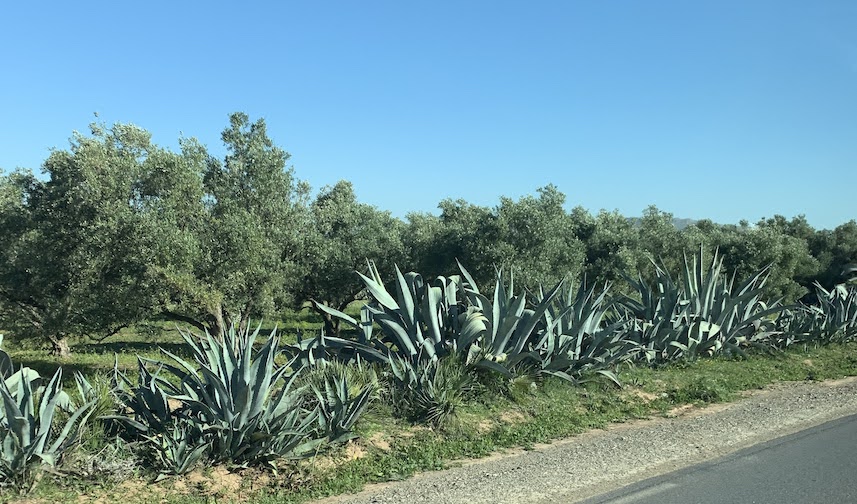
But, he told us, one of the other cash crops in the area is hashish. He said there are efforts underway to make it legal for medical use.
Chefchaouen is also known as the “Blue City”. Even from a distance you can start to understand why. Many of the buildings in the city are painted different shades of blue. Our local guide told us that the color “helped repel mosquitos and attract tourists”.
We spent less than 24 hours there, but our experience supported his logic.
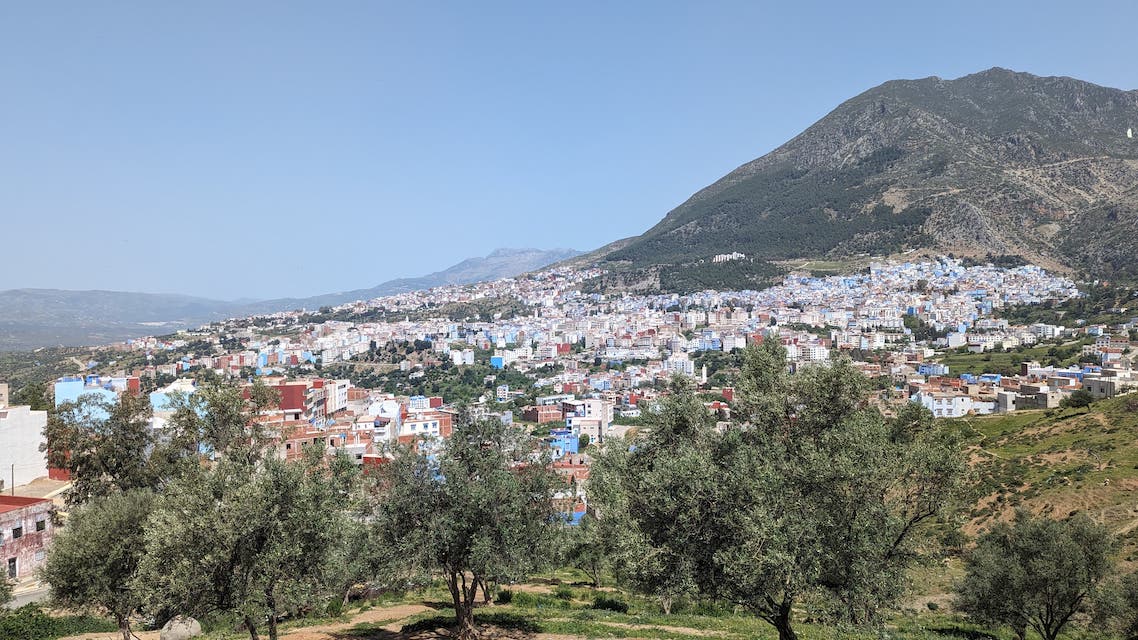
Image credit: Daniel Gusella
We walked through the city for several hours the first afternoon and again the next morning. The shades of blue changed with the changing light, and most of the time we were bathed in a soft, blue glow.
Here are a few photos that show off the beauty of the town.
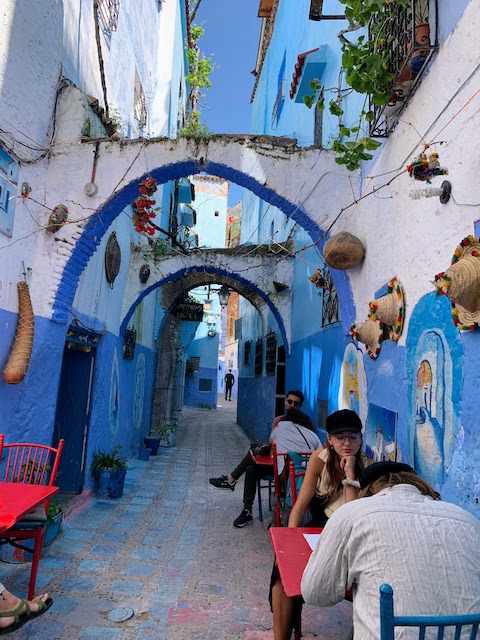
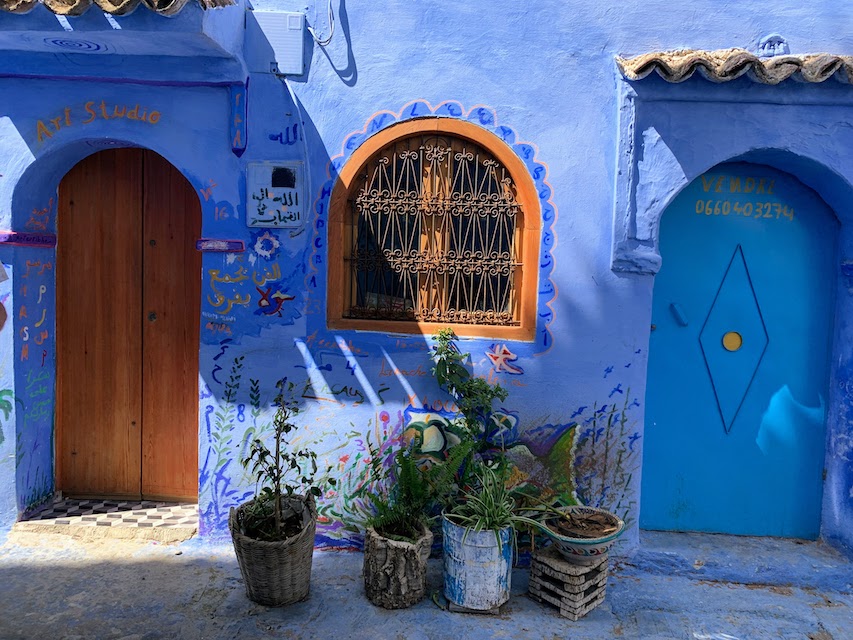
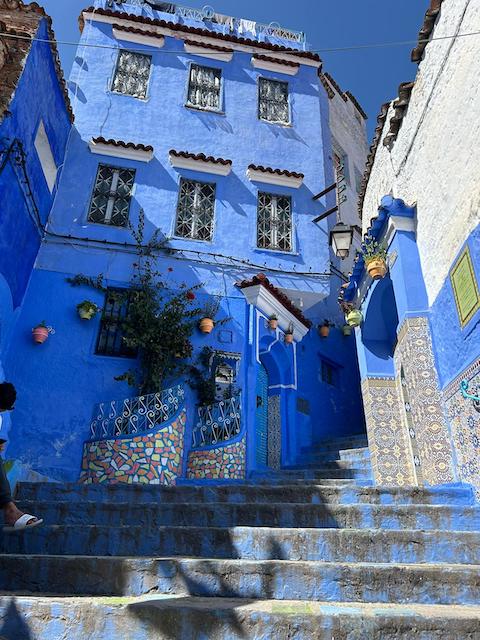
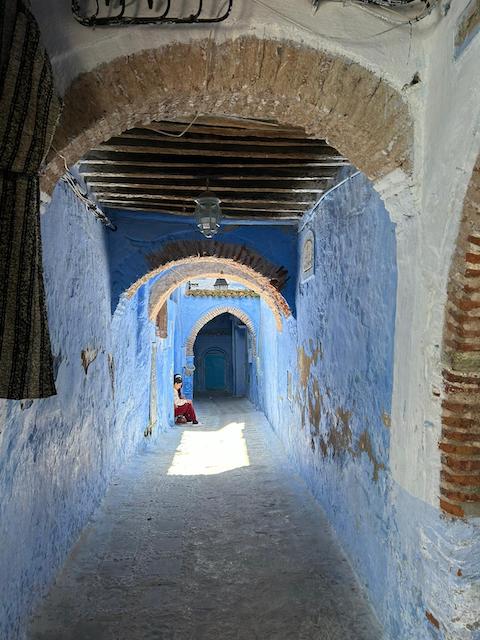
During our walking tour, Mohammed, the local guide, told us that the paint used on the buildings was made by mixing colored powders with water. (This is what we might call “tempera paint”.)
Because it was water-based, he said, the buildings had to be repainted once a year. This was often done before major holidays or family celebrations, like weddings.
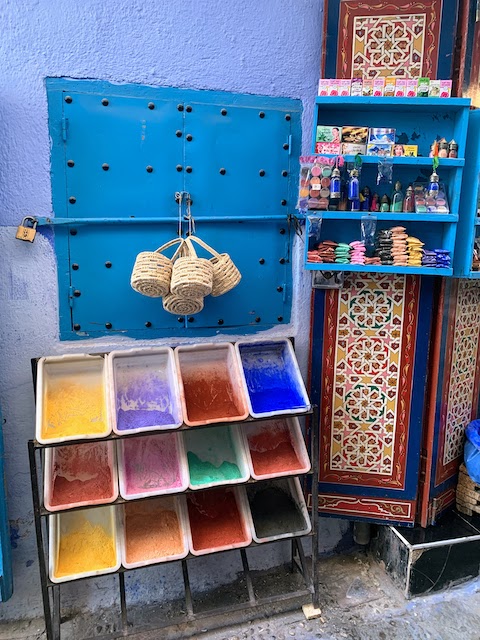
Fes
To get to Fes, we backtracked down the same road that brought us to Chefchaouen, but turned east near the end. Just after the turn, we stopped for photos of the Oued Tizguit, a large lake that supplied water for much of the region. Once again, we were surprised by the lush greenery.
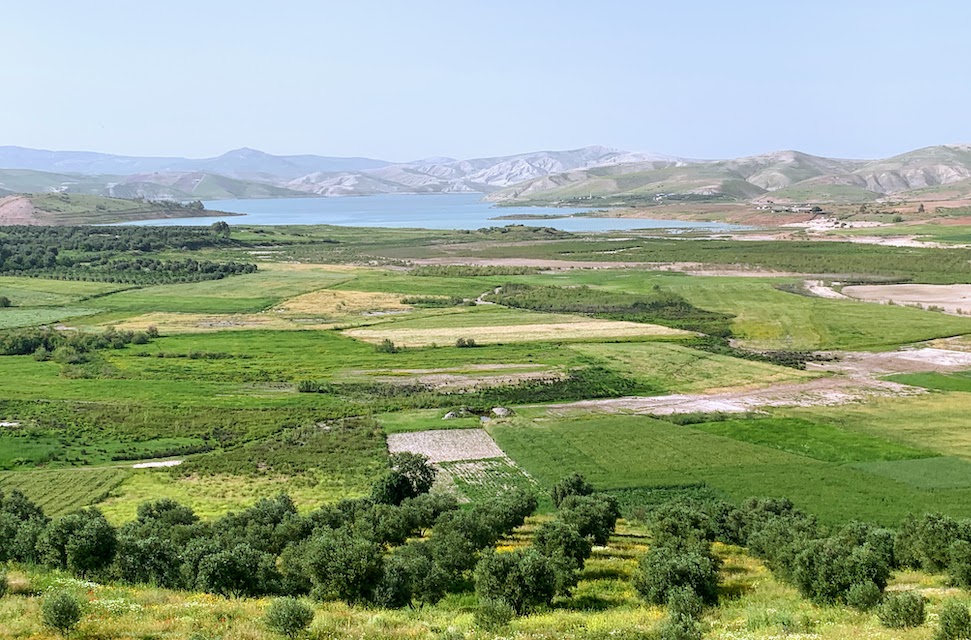
We arrived in Fes late in the afternoon and after getting checked in at the hotel, our group went to a private home for one of the best meals we had during our trip. (More on that next time.)
We left the tour the next morning and only saw Fes through the window of a taxi going to the train station.
Marrakech
The train to Marrakech took 6 1/2 hours. This could have been the train many of us sang about years ago, though I suspect our ride might have been more comfortable than the one Graham Nash took in 1966. (And I doubt that many of us even knew where Marrakech was.)
We sprang for seats in a first class compartment. They were only about $10 more than second class, so it was an easy decision. We had nice upholstered seats in an air conditioned compartment that comfortably sat six people.
We had booked a room at the Riad Diamond of Marrakech hotel. It was in the heart of the medina, which made getting to it a challenge.
The first hurdle was finding a cab driver who recognized the address. We tried several, all of whom shook their heads. The guy who finally agreed to take us pulled away from the curb and then said “Give me GPS!”, meaning “Hand me your phone with the map.” So he navigated across town to the edge of the medina using my Google map.
A policeman stopped him from driving into the medina. After some harsh words were exchanged, the cabbie motioned for us to get out. He pointed across the open square, indicating where we needed to go. I tried to hand him the fare that had shown up on the meter – about 30 Moroccan dirhams – but he shook his head. “Not enough! Give me 50!”
I’d been told to expect that amount, so I gave him the money. At roughly 10 dirhams to the dollar, whether I paid him $3 or $5 wasn’t enough to argue about.
With some help from Google Maps, we wound through the main square and down a narrow alley to the hotel. Once inside, we were greeted by a friendly young woman who escorted us to a formal sitting room and insisted we have some mint tea and sweets while she completed the registration forms. It was 35ºC / 95ºF outside, so hot tea wasn’t exactly what we wanted. But we accepted the hospitality and sipped slowly while we cooled off.
A riad is a traditional Moroccan home built around an inner courtyard. Many have very plain exterior doors, but open to opulent interiors. The Diamond had once been a private home to a large family. It was the nicest hotel we stayed in during our trip.
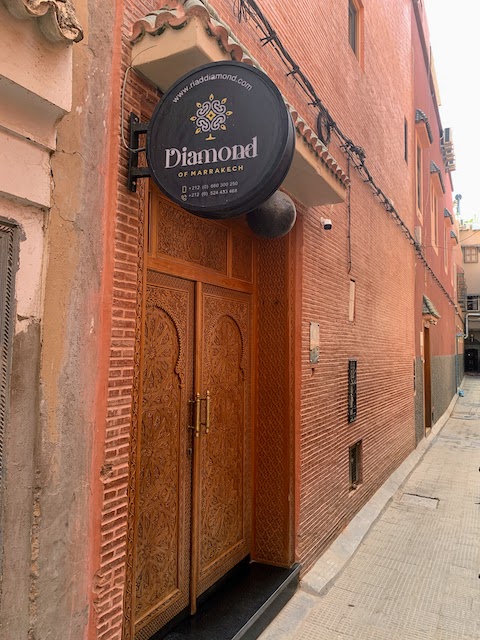
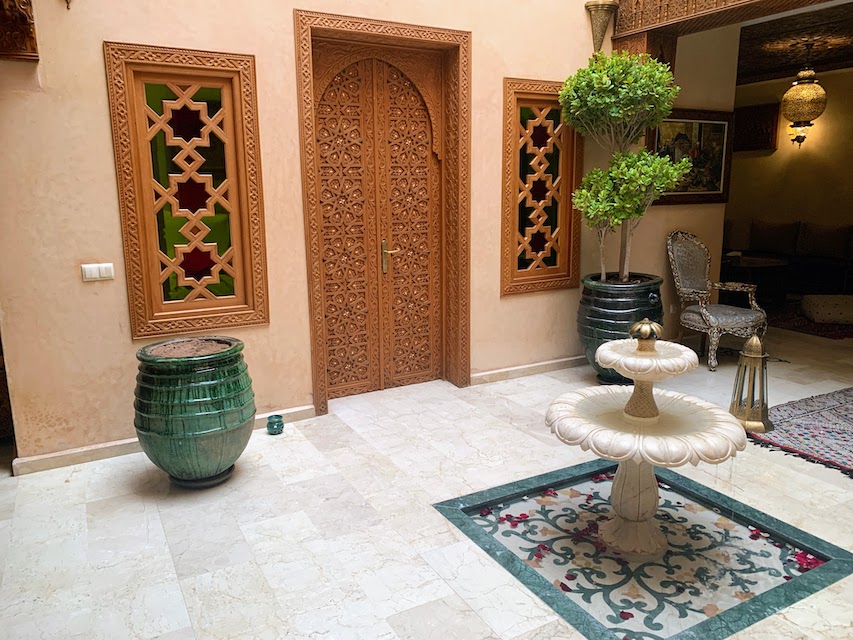
That evening and the next morning, we spent several hours wandering through the medina. We got lost, as all the guidebooks say you should do. But we also encountered several friendly Moroccans who noticed our puzzled looks and helpfully pointed us back to the main square.
And, as we’d been advised to do, we haggled with a shop keeper over the price of a souvenir.
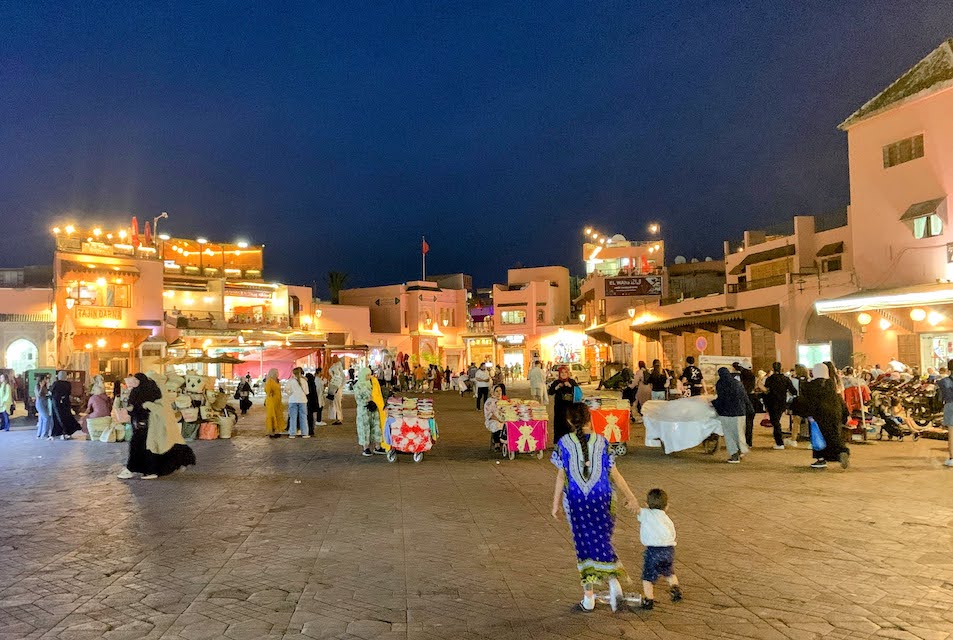
The main square of the medina was brightly lit and busy at night.
And even at night there was lots of fresh produce for sale.
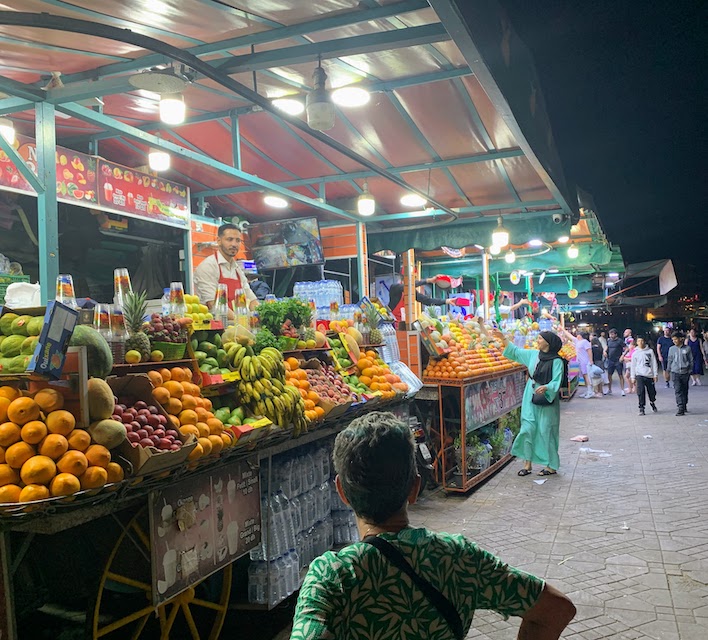
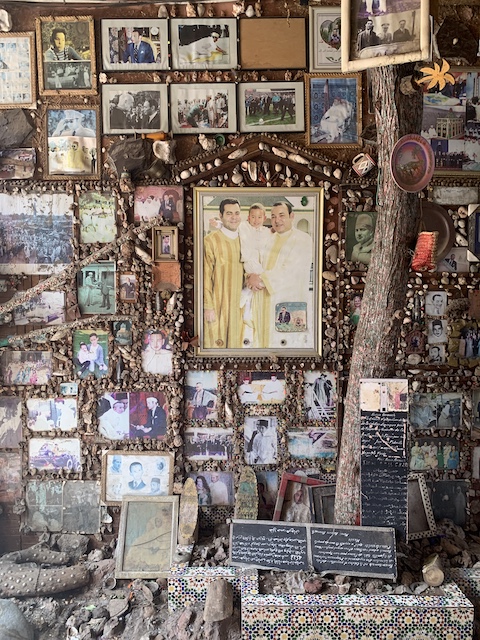
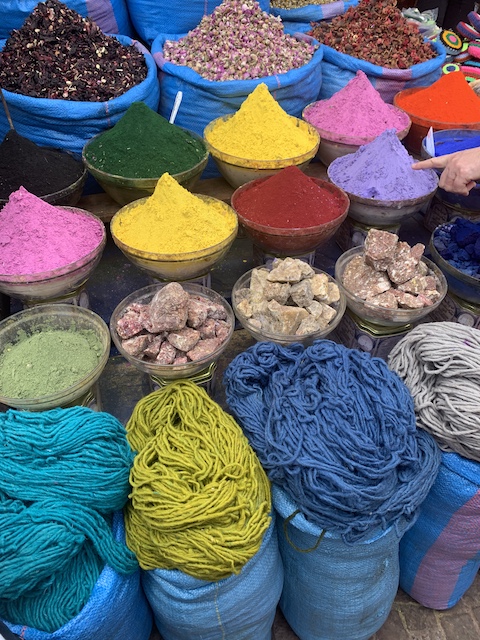
We also managed to avoid being run over by the speeding scooters and donkey carts that shared the narrow passageways with pedestrians.
So I guess we had the total medina experience.
We had to leave too soon
We caught a flight out of Marrakech to Lisbon in the middle of the afternoon on Wednesday. When we landed, we took an Uber straight to the animal hospital.
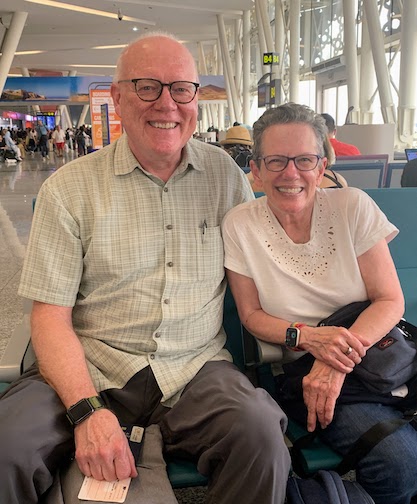
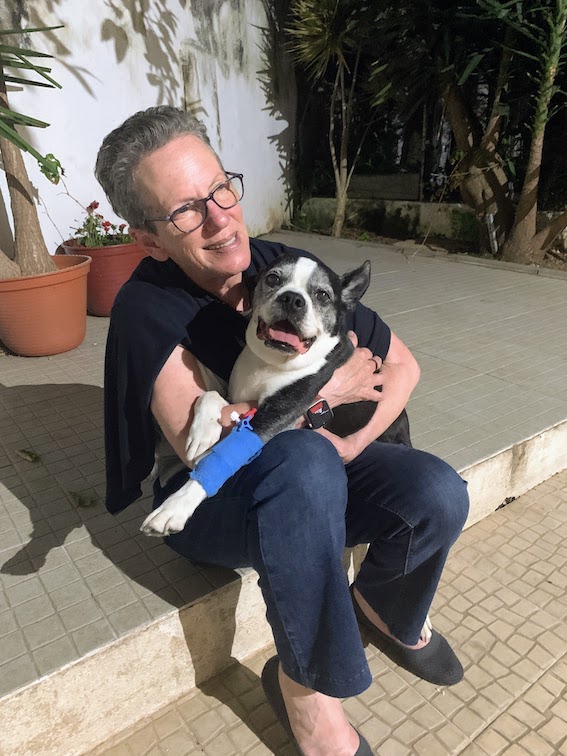
Sox was still in the hospital, and groggy from a procedure earlier in the day, but we were all happy to be together again.
After two more nights in hospital, Sox came home on Friday. She is on a variety of medications to treat stomach, intestine, and liver problems. Her recovery is slow going, but we’re hopeful as we watch her regain her strength.
While we didn’t have all the time we wanted, we enjoyed getting to know the members of the tour group. They were all veteran travelers who came with curiosity, empathy, and good humor. We hope we’ll have a chance to travel with them again some time, somewhere.
And we appreciate Cathy, Daniel, and Jonathan for allowing us to use some of their excellent photos to illustrate this post.
Until next time / Até a próxima vez
Mary and Mike
The Cook and The Writer

Have you had a travel experience that challenged your preconceived notions? Tell us what surprised you in the comments below or via the Contact Us form.

Amazing pictures and a happy ending for Sox — what a great blog! Love reading about your adventures and traveling vicariously!
You guys have had some great adventures. I enjoy the pictures and the narrative that accompanies them.
What a colorful place to visit. Always thought of seeing Casablanca, but won’t be able to make this life. So glad to see it through your eyes. So happy Sox is doing better. Our furry children are family ❤️
What an adventure! Morocco is not somewhere I had a desire to visit but now I’m rethinking that. Love your photos. So so happy Sox is back with Mom and Dad.
Looks like a great adventure. But glad to hear Sox is doing better. Have a great weekend.
John
Glad Sox is doing better! Isn’t it a delight to explore and experience such marvelous differences in culture, colors, foods, and “getting lost!”
David
that’s too bad that your trip had to be cut short – and how stressful for you to be so far away while Sox was ill, for your petsitter (no one wants to have to take their babysitting charge to the vet!), and of course, for poor Sox! I’m glad she’s feeling better and I hope she quickly makes a full recovery.
It sounds like you made the most out of your shortened trip. Thanks for sharing your adventure and happy to know that Sox is feeling better! -CW
I must admit I skimmed through your post at first, anxiously worrying about Sox. Sorry your trip was cut short, but glad Sox is home again.